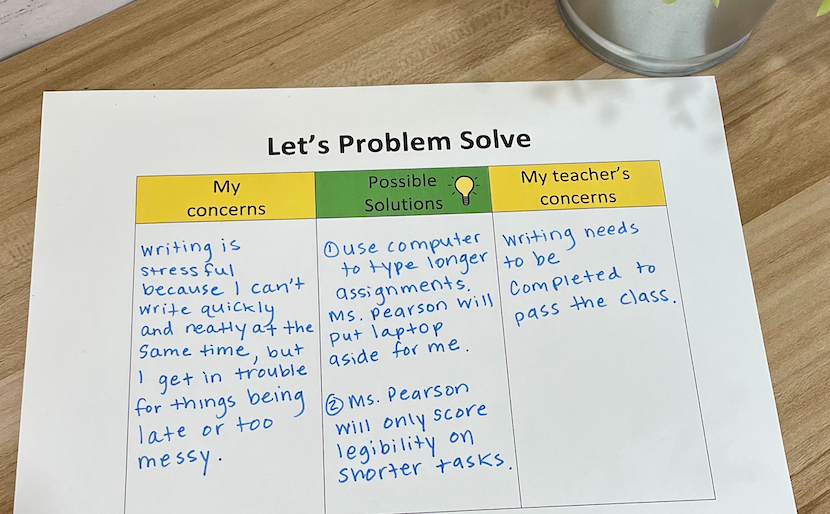Stop Punishing and Start Problem Solving: Collaborating With Your Student to Meet Everyone's Needs

You start handing out math packets and Johnny immediately puts his head down. “Great…here we go again” you think to yourself. By the time you have finished passing out papers, Johnny is already stomping on his under his desk.
PAUSE
So often we see a disruptive or challenging behavior occur and immediately start thinking of consequences we can give to ensure that behavior doesn’t happen again. “That’s it, go to the office” or “You need to stop doing that – that’s not okay!”
But, let’s be honest – responding in ways such as these are often ineffective. One of the big reasons we are against emotional, unplanned responses such as these is because they often harm the student-teacher relationship. If you want your student to cooperate with expectations, you aren’t going to get there by imposing consequence after consequence. Punishments (and yes, a consequence meant to decrease disruptive behavior is, by definition, called a punishment), are ethically should not be the first line of defense due to the potential of adverse side-effects such as increased aggression, passive aggressiveness, and avoidance behaviors. This is why we often see educators get more entrenched in the cycle of problem behaviors and ineffective consequences; the more we give, the worse the behavior sometimes gets.
“Okay, but he needs a consequence, he can’t just continue to do XYZ in this classroom.”
We hear you! We can’t have Johnny destroying his work every time we pass it out. After all, how will he ever be able to independently go out into the community if he is throwing milk down the grocery aisles? But, when we focus on just getting our needs and agenda met as the adult, we aren’t helping our student long-term.
This is why it is critical we shift the way we are approaching our student’s behaviors. Instead of relying on more punitive practices, we need to be focusing our efforts on problem-solving the reason the behavior is occurring. Sometimes a student may be exhibiting an extremely disruptive or challenging behavior due to a problem that might be extremely easy to solve and we don’t need to develop a behavior support plan. Yet, because these students often lack problem-solving skills, frustration tolerance, and the ability to functionally communicate to name a few, the behavior that has worked in the past to get their need met continues. But again, there will be many times when that problem is easily-solvable if we just slow our roll and talk with them.
You may be familiar by Dr. Ross Greene who coined the Collaborative Problem Solving approach. We aren’t here to dig deep into the process, nor are we were to discuss the pros, cons, or level of appropriateness of this process for certain students. But, we are here to discuss the fact that problem solving with the student, rather than solely focusing on “what consequence needs to be given” is far more likely to be effective.

A simple template like this can be used to assist you in the conversation. You can certainly problem solve with the student in the moment if they haven’t escalated to a point where they just aren’t cognitively available. Other times it is more appropriate to sit down with the student outside of that moment so you have more time to identify what is going on and develop viable solutions.
First, gather information about your student’s concerns. You might start with something like, “Hey, I notice you’re having difficulty getting math done. What’s up?” Let them talk! This is their perspective, so don’t try and “correct” it. Ask some probing questions to figure out what their need or concern is. This is really where we focus on being empathetic, just leave the judgement aside. You may not agree with or like what they have to say, but this isn’t about just you - it’s about both of you. Actively listening and acknowledging their concerns shows them you are actually here to help them. It also makes it more likely they will see things from your perspective when it’s your turn – another skill many students struggle with.
Next, share your concerns and perspective. Keep your tone of voice in check and calmly state your view on the matter. Try and give just the facts and avoid making assumptions or pushing your agenda.
Lastly, brainstorm solutions that meet both of your needs. If only your needs are met, you may be back to square one. You might say, “Hm, what do you think a solution to this would be?” Encourage them to assist in solving the problem (this will help with buy-in as well). Once you agree upon a solution, help them carry it out. This may be involve some visual reminders of the solution you decided upon, some instruction and role-play to practice a new skill, or simply a minor shift to your instructional approach.




